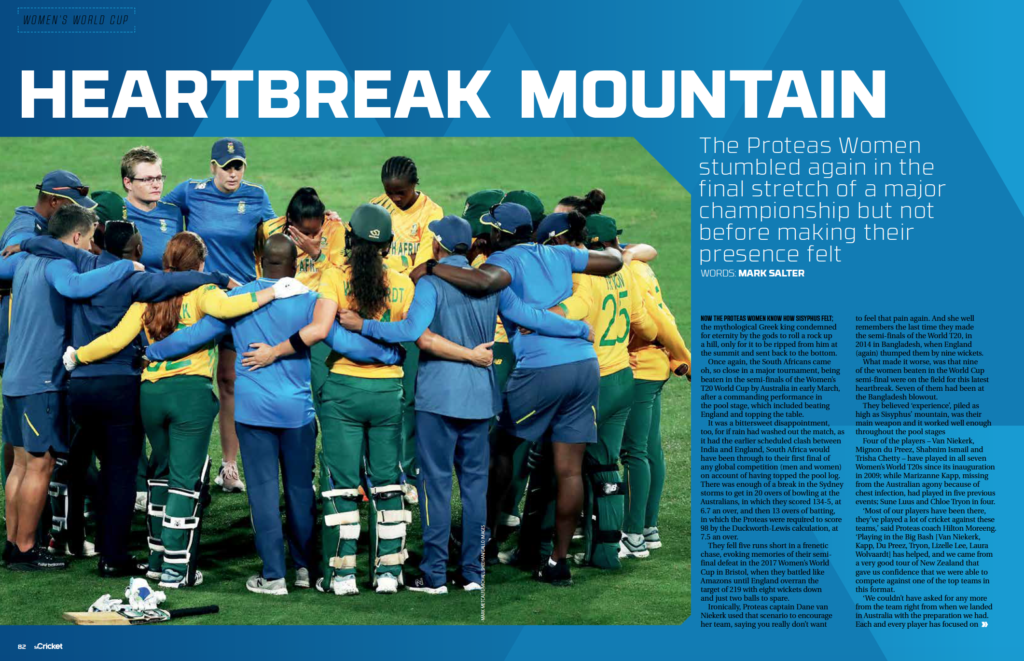The Proteas Women stumbled again in the final stretch of a major championship but not before making their presence felt, writes MARK SALTER.
Now the Proteas Women know how Sisyphus felt; the mythological Greek king condemned for eternity by the gods to roll a rock up a hill, only for it to be ripped from him at the summit and sent back to the bottom.
Once again, the South Africans came oh, so close in a major tournament, being beaten in the semi-finals of the Women’s T20 World Cup by Australia in early March, after a commanding performance in the pool stage, which included beating England and topping the table.
It was a bittersweet disappointment, too, for if rain had washed out the match, as it had the earlier scheduled clash between India and England, South Africa would have been through to their first final of any global competition (men and women) on account of having topped the pool log. There was enough of a break in the Sydney storms to get in 20 overs of bowling at the Australians, in which they scored 134-5, at 6.7 an over, and then 13 overs of batting, in which the Proteas were required to score 98 by the Duckworth-Lewis calculation, at 7.5 an over.
They fell five runs short in a frenetic chase, evoking memories of their semi-final defeat in the 2017 Women’s World Cup in Bristol, when they battled like Amazons until England overran the target of 219 with eight wickets down and just two balls to spare.
Ironically, Proteas captain Dane van Niekerk used that scenario to encourage her team, saying you really don’t want to feel that pain again. And she well remembers the last time they made the semi-finals of the World T20, in 2014 in Bangladesh, when England (again) thumped them by nine wickets.
What made it worse, was that nine of the women beaten in the World Cup semi-final were on the field for this latest heartbreak. Seven of them had been at the Bangladesh blowout.
They believed ‘experience’, piled as high as Sisyphus’ mountain, was their main weapon and it worked well enough throughout the pool stages
Four of the players – Van Niekerk, Mignon du Preez, Shabnim Ismail and Trisha Chetty – have played in all seven Women’s World T20s since its inauguration in 2009; while Marizanne Kapp, missing from the Australian agony because of chest infection, had played in five previous events; Sune Luus and Chloe Tryon in four.
‘Most of our players have been there, they’ve played a lot of cricket against these teams,’ said Proteas coach Hilton Moreeng. ‘Playing in the Big Bash [Van Niekerk, Kapp, Du Preez, Tryon, Lizelle Lee, Laura Wolvaardt] has helped, and we came from a very good tour of New Zealand that gave us confidence that we were able to compete against one of the top teams in this format.
‘We couldn’t have asked for any more from the team right from when we landed in Australia with the preparation we had. Each and every player has focused on the task and used our experience of playing in these conditions.’
Yet it was not enough, and Van Niekerk had to admit that Australia’s greater professionalism and experience was the decisive factor in defending 98.
‘You have to give them credit. They bowled extremely well; they bowled to their plans and they restricted us,’ she said.
The South Africans’ required run rate of 7.5 an over demanded a quick start, but they were pegged back to 24-3 and although Wolvaardt and Luus accelerated, the RRR was always out of reach against tight bowling at the death.
Was there just a tinge of regret that the weather did not help them out, as it had for India?
‘No, not at all,’ said Van Niekerk. ‘We came here to play cricket and we knew that to get into the final we had to beat the best. I would rather lose than get a free pass into the final.’
Given that South Africa have never beaten Australia in any form of the game, that was a courageous statement. Their confidence, asserted Van Niekerk, was boosted, not just by experience, but by the intricate culture of the team.
‘Everyone knows our hashtag, “We are more”. The culture in this team is that we are more than just cricketers; we are wives, sisters, daughters; we are lots more than that. The culture is just incredible.’
It was certainly enough to spring one of the great surprises of the tournament, beating England, which ultimately resulted in South Africa topping the pool.
It would be tempting to point to a few key moments in securing South Africa’s first win against the powerhouse team in the World T20 and only their third ever. First there was a superb bowling performance, led by Kapp conceding just 19 runs and taking two wickets in four overs, and Ayabonga Khaka’s 3-25, which restricted the total to just 123. Then there was the solid foundation partnership of 84 between Kapp and Van Niekerk which gave Du Preez and Tryon the base from which to launch their assault in the last three overs, when South Africa needed 33 runs. Social media uncharitably reran footage of Katherine Brunt declining to ‘mankad’ Luus in the last over, immediately before Du Preez slammed a six which to all intents and purposes settled the affair.
That loss cost England their chance of winning the Women’s World Cup for they ended second on the Pool B log and were automatically eliminated when rain washed out the semi-final. Australia were in the same predicament after a surprising day-one loss to India.
South Africa went about their task in the pool stage with clinical efficiency. Their second match, against Thailand, produced the highest score in Women T20 history, 195-3, on the back of a maiden T20 century for Lee, that edged out India’s 194 against New Zealand in 2018. That was followed by an equally imposing victory over Pakistan by 13 runs. Rain then washed out the match against West Indies, who had beaten only Thailand and had been comprehensively dismissed by Pakistan and England.
On reflection, it was a disappointing batting return from the senior and most experienced leaders: while Lee led the table with most runs, 101 of her 119 came in one game. Just 18 were scraped together in three other matches. Van Niekerk accumulated 63 at an average of 15 while Du Preez gathered 35at an average of 17. Luus emerged with a creditable 95 at an average of 47, but the standout performance came from the 20-year-old Wolvaardt, playing in only her second World T20. She smashed 94 in two innings, and led her team’s strike rate with 149 (ignoring Nadine de Klerk’s six from two balls, which gave her a strike rate of 300).
Going into the tournament the spirit of the South Africans had been lifted, too, by a great run of form in ODIs, which saw them qualify automatically for the World Cup in 2021 as one of the top four teams. In the previous three editions, they have always faltered and forced to attend a qualifying tournament. Series wins over Sri Lanka and New Zealand enabled them to secure fourth place with one series – against Australia – remaining.
That is but a small consolation as they begin to roll the rock of expectation up their next mountain.
THE SA CAMPAIGN
Beat England by 4 wickets. Set a target of 124, the Proteas got there with two balls remaining after requiring nine runs off the final over. Captain Dane van Niekerk top-scored with 46 after Ayabonga Khaka had been the standout bowler, with 3-25.
Beat Thailand by 113 runs. Lizelle Lee struck a 60-ball 101 as the Proteas rattled up 195-3 from their 20 overs, the highest-ever score in a women’s T20 International. They then restricted their opponents to 82 all out with Shabnim Ismail and Sune Luus each taking three wickets.
Beat Pakistan by 17 runs. Coming in at No 5, Laura Wolvaardt hit an unbeaten 53 off 36 balls to help the Proteas reach 136-6 in their 20 overs. Aided by two runs outs, they always had the measure of Pakistan who were restricted to 119-5.
No result vs West Indies. The match was rained off without a ball being bowled but the point the Proteas got saw them top their pool ahead of England and set up a semi-final against hosts Australia.
Lost to Australia by 5 runs (D/L method). Oh, the drama. Restricted Australia to 134-5 in their 20 overs, with Nadine de Klerk picking up 3-19, before the rain returned. SA were asked to make 98 to win off 13 overs but reached 92-5 to lose by five runs.
MOST RUNS
119 Lizelle Lee
95 Sune Luus
94 Laura Wolvaardt
69 Marizanne Kapp
63 Dane van Niekerk
47 Chloe Tryon
35 Mignon du Preez
HIGH SCORES
101 Lizelle Lee (vs Thailand)
61* Sune Luus (vs Thailand)
53* Laura Wolvaardt (vs Pakistan)
46 Dane van Niekerk (vs Eng)
41* Laura Wolvaardt (vs Australia)
38 Marizanne Kapp (vs Eng)
MOST WICKETS
5 Shabnim Ismail
4 Dane van Niekerk
4 Ayabonga Khaka
4 Nadine de Klerk
3 Sune Luus
3 Nonkululeko Mlaba
2 Marizanne Kapp
BEST FIGURES
3-8 Shabnim Ismail (vs Thailand)
3-15 Sune Luus (vs Thailand)
3-19 Nadine de Klerk (vs Australia)
3-25 Ayabonga Khaka (vs England)
2-19 Marizanne Kapp (vs England)
2-20 Dane van Niekerk (vs England)
PREVIOUS WORLD CUP RESULTS
2018 in West Indies: Group stage
Beat Sri Lanka by 7 wkts
Lost to West Indies by 31 runs
Lost to England by 7 wkts
Beat Bangladesh by 30 runs
2016 in India: Group stage
Lost to Australia by 6 wkts
Beat Ireland by 67 runs
Lost to New Zealand by 7 wkts
Lost to Sri Lanka by 10 runs
2014 in Bangladesh: Semi-finals
Beat Pakistan by 44 runs
Lost to Australia by 6 wkts
Beat Ireland by 86 runs
Beat New Zealand by 5 wkts
Lost to England by 9 wkts (semi-final)
2012 in Sri Lanka: Group stage
Beat Sri Lanka by 6 wkts
Lost to New Zealand by 22 runs
Lost to West Indies by 10 wickets
2010 in West Indies: Group stage
Lost to West Indies by 17 runs
Lost to Australia by 24 runs
Lost to England by 56 runs
2009 in England: Group stage
Lost to West Indies by 4 runs
Lost to New Zealand by 6 wkts
Lost to Australia by 24 runs
– This feature first appeared in the April-June issue of SA Cricket Magazine







